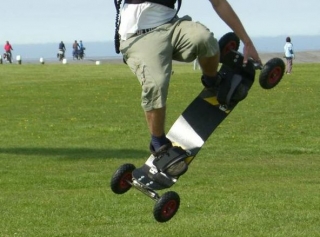
If you already have a bike and want to go on a route, or if you don't have one but fancy heading to the mountains, don't forget to check out the cycling routes we have in nearly all Spanish provinces.
Do I want to ride around the city? Will I be covering long distances? Do I prefer mountain descents?
Mountain Bike. This all-terrain bicycle will let you ride on sandy or mountainous paths without any problems. Generally, these bikes have front suspension but no rear suspension. This allows you to ride on uneven and imperfect paths, as it softens the roughness of the terrain.

On the other hand, if you're after something more action-packed, considering freeride among your options, it's a great idea to choose an MTB with disc brakes, as these perform best during steep descents.
Urban bicycle. If you want a bike for leisurely rides, commuting, or shopping, and you'll only be using it on tarmac, don't hesitate to choose one of these models. To ensure comfort, pay special attention to the size and shape of the wheels: they should be large and thin.

You can also add a basket or panniers if you like, making it more comfortable and practical for running errands on your way home.
Road bike. These are perfect if you want to do sport, but only on tarmac. Their wheels are thin to minimise friction with the ground, allowing you to ride faster. Pay special attention to the gears: it should have at least two chainrings to make gear changes easier depending on the gradient you're riding.

To avoid injuries or discomfort in your back, knees, neck, or arms from choosing the wrong-sized bike, make sure it can adapt to all your body proportions.
To determine the correct size, don't focus on your overall height but rather on your leg length. How do you measure it? From the ground to your crotch. Once you have this measurement, multiply it by 0.54 to get the frame size in centimetres (which corresponds to the seat tube length); if you want it in inches, multiply by 0.21.
It's very important to rely more on the measurement in centimetres than on the sizes some manufacturers use: L, XS, M, etc., as these are less precise.

A trick to check if the bike is perfect for you is to sit on it and place your feet on the pedals. If you can stretch one leg without lifting your heel from the pedal and without bending your knee, the size is ideal.
For women, it's best to focus on women's bikes, as even if a man and woman are the same height, their body proportions are obviously different. This is why the top tube is shorter, handlebars need to be narrower, the saddle should be slightly further back and wider...
The saddle should be completely parallel to the ground, meaning it shouldn't tilt upwards or downwards. While many people find they're more comfortable during descents with a slight upward tilt of the seat, if you're not practising this discipline, it's best to adjust it according to your primary use.

As for the handlebar height, set it so that your body, when seated on the saddle, leans at about 45°. The ideal height allows you to turn the handlebars freely without twisting your torso. This way, your arms can remain slightly bent, acting as suspension to absorb bumps, while staying rigid on steeper descents without causing imbalance.

Tips:
- Once you've bought a bike, you'll need to maintain it properly to extend its lifespan.
- When practising this sport, warming up beforehand is crucial to avoid injuries.
What about you? What type of bicycle do you use? Which one best suits your needs?
















